The period we think of as "Ancient Greece" or classical Greece lasted from about the 8th century BC to about the 2nd century BC, by which time the Romans were pushing into Greek territory. Before that, we have the Mycenaen period (the era depicted in the Illiad) from 1600 to 1100 BC, which was followed by the Greek Dark Ages (1100 BC to 800BC).
So we are talking about a pretty long time, and the evidence of Greek clothing that we find from pots and statues shows clothing that varies considerably in detail. However, just as western European clothing for women from the middle ages to the 19th century showed a certain form (blouses, skirts and dresses, all of ankle length), Greek clothing can be condensed down into three main items - the peplos, the chiton and the himation.
Of course within these items, you have incredible variation - mainly white clothes give way to dyed clothes by the 5th century BC as the Greeks learn to make dye permanent on cloth. Pots indicate intricate embroidery and patterns on the chitons and himations. Wool and linen clothes are supplemented with cotton imported from India for the very rich, from the 5th century BC onwards (the Greek historian Herodotus wrote of India, "there are trees which grow wild there, the fruit whereof is a wool exceeding in beauty and goodness that of sheep. The natives make their clothes of this tree-wool").
The Greeks liked their clothes loose, probably because of their climate.
How the Greeks made their Clothes
All Greek clothes were made in the home, by the women and slaves. Most of what we know about how they did it comes from a pot by the Amasis pot above, which depicts in detail all the stages of clothing manufacture.
You can see them going through all the stages from spinning the thread from wool or linen, to weaving the cloth on a loom, to folding the finished product, which was a rectangular piece of cloth. This was then ready to be fashioned into simple clothes, with patterns either woven or printed onto the cloth.
The cotton imported from India was ready woven.
The Peplos
As you can see from the image above, the Peplos was essentially two pieces of rectangular cloth, which were partially stitched together on the sides, leaving a large section at the top un-stitched. The person slipped the tube of cloth down their body, and then folded the top part down at the back and the front, to create the apoptygma. Note that they don't fold at the point where the stitching ends, but a little higher, to make room for an opening for the arms. Then the back and the front are joined together at the shoulders by a brooch or fibulae.
A belt was usually worn with it, either visible below the apoptygma, or under it, depending on how low the apoptygma went. Sometimes, if the peplos material was long, the belt was worn low, and then material pulled over it, to form a blouse effect.
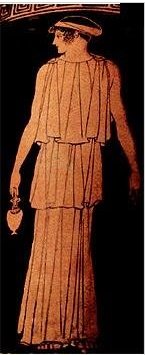
In the image above, which is from a pot in the Greek Herakleion Museum, the woman is wearing a peplos, but she's also worn a belt, to secure the garment to her body, and then pulled material over the belt to form a second tiered effect.
The Chiton
As you can see from the image above, the chiton is also two rectangular pieces, that are sewn at the sides - but the chiton is made from much wider material. At the top, a length is left open to make sleeves, and it is then fastened by a series of brooches along the shoulders.
The voluminous material was then fastened at the waist with a belt, allowing the cloth to drape in folds and pleats against the body. Material was pulled out over the top of the belt, so a blouse effect was created and the belt was hidden.
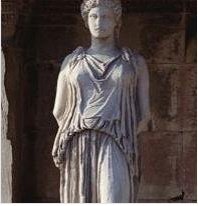
The statue above is a caryatid from the Acropolis, and she's wearing a chiton. Both men and women wore chitons, but the mens version usually only came to the knees, the women's versions were always ankle length.
The Himation
The Himation was really used as a sort of cloak. It's a single large rectangular piece of cloth big enough to drape right round the body - about five feet wide and seven to eight feet long - and leave an elegant fold hanging down.
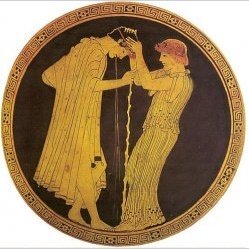
In the image from a drinking cup dating to 490BC, the man on the left is wearing a himation, which he has left open (the woman on the right is wearing a chiton). Most men simply pinned the two ends with a fibulae on the left shoulder and let the rest of it drape down over their bodies.
Most women tied their himation. This was done by bringing one end of it over the left shoulder and tucking it into their belt, and the other end goes across the back and under the right arm, and is then brought across the breast, over the left shoulder, with the end either hanging at the back, or brought under to drape over the left arm.
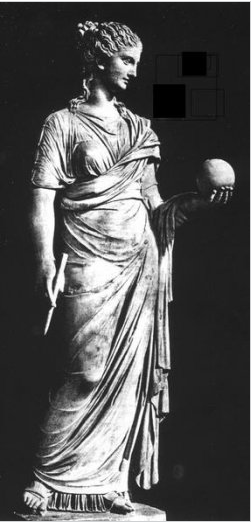
In the statue above, the woman is wearing a himation over her chiton.
You can see that her chiton has sleeves, and is fastened with brooches all the way down the arm. Her himation has been tucked firmly around her, producing a drape effect, from which her pleated chiton peeks out at her ankles.
Conclusion
As you can see, there wasn't a lot of sewing involved in creating ancient greek clothing. Instead all the beauty of the dress was in the cloth (it's quality and the embroidery or patterns woven into it), and in how you draped and tied it.
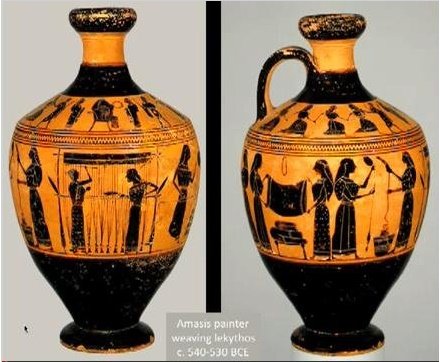
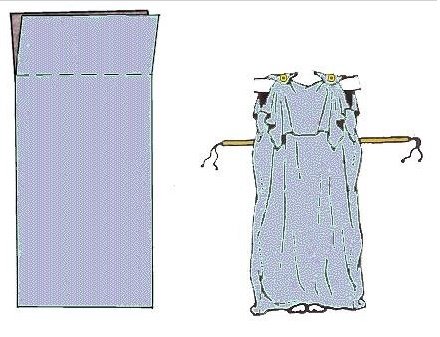
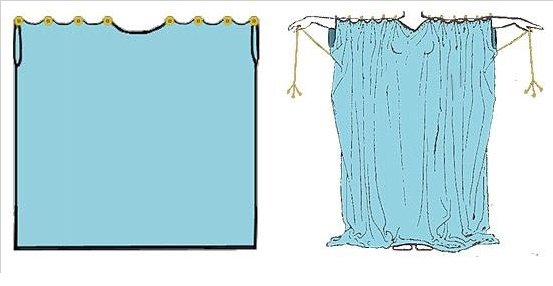
Very nicely written ! what a fab quote.. tree wool
"there are trees which grow wild there, the fruit whereof is a wool exceeding in beauty and goodness that of sheep. The natives make their clothes of this tree-wool").
Toga parties.. we used to wear a sheet to a party and get drunk, you can imagine what happened next (they all start falling off )
Downvoting a post can decrease pending rewards and make it less visible. Common reasons:
Submit
Yeah - I guess if you hadn't seen cotton before, it looked like a very mysterious thing!
Downvoting a post can decrease pending rewards and make it less visible. Common reasons:
Submit
following the historian ! ;)
Downvoting a post can decrease pending rewards and make it less visible. Common reasons:
Submit
yes. Cotton is one of the backbones of civilisation. I saw a tree recently here in London which had just flowered and left masses of what looked just like cotton on the ground.. I examined it closely and thought, this would make a lovely natural fibre.. I don't know what the tree was.. it certainly wasn't cotton (not warm enough in the UK) but i wasn't aware of any other cotton like materials which are cultivated.. perhaps you know of other TREE WOOLS
Downvoting a post can decrease pending rewards and make it less visible. Common reasons:
Submit
I think flax produces linen - but it's not a tree, more like a grass. And then you get really rough sack-cloth made from sisal fibres, it's good for sacks and ropes, but you wouldn't want to wear it. Cotton really is the best because you get such a high yield per acre.
And then there are the animal-based fibres - silk, goats hair, cashmere (which I think is a mountain goat), and of course wool. And don't forget leather made from animal hides. I think the first clothing would have been hides and fur stitched together and only later did they start weaving cloth using wool and cotton.
Downvoting a post can decrease pending rewards and make it less visible. Common reasons:
Submit
yeah my mum had flax plants..and sisal is ok for making sacks. hemp is great but more like linen. theres also coir for mats and of course the animal fibres.. apparently dog hair makes wonderful wool for pullovers and I have a friend who is a textiles expert.. (actually I have a few) !! and she said she'd heard of someone making a very nice top from milk protein ?
https://www.linenme.com
(here's an explanation of wools from linenme.com
Sheep’s Wool.
It is traditional wool that can be made from any sheep fleece.
Merino Wool.
Merino wool is taken from a Merino Sheep and has fine, soft appearance of the fabric. It is quite expensive. The distinction from other types of wool is its resistance to pilling.
Mohair Wool.
Mohair is taken from Angora goat. It is not very soft and many people find it a very itchy fabric to wear directly next to the skin.
Angora Wool.
Angora wool is made of an Angora rabbit hair. Its main quality is its fluffy surface texture and its soft touch. It is expensive, as it comes from a specific breed of rabbit. To improve fabric stability Angora is often blended with Nylon.
Cashmere Wool.
Cashmere is soft and luxurious fabric. The fibers that are used to make cashmere come from specific areas of the fleece of a cashmere goat, and that is why it is so expensive.
Alpaca Wool
made from the hair of Peruvian alpacas, but it also also can come from similar fibers of mohair, Icelandic sheep or even high-quality English wool. Alpaca fleece is a lustrous, silky, soft and therefore luxurious natural fiber. It is warmer than usual wool, not prickly, and bears no lanolin, and therefore – hypoallergenic.
Downvoting a post can decrease pending rewards and make it less visible. Common reasons:
Submit
I wonder how that works - it conjures up a top made of string cheese!
Downvoting a post can decrease pending rewards and make it less visible. Common reasons:
Submit
I can't imagine.. but I bet it makes a slinky fabric. you can probably make fabric out of many things if you could be bothered. I find it amazing there was no industry for clothes making in Ancient Greece, even though they imported ready made cotton from India. really, did nobody produce off the peg clothes in Ancient Athens ??? come on
Downvoting a post can decrease pending rewards and make it less visible. Common reasons:
Submit
It was all made at home, by the women and the slaves. That was their job.
Downvoting a post can decrease pending rewards and make it less visible. Common reasons:
Submit
Thank you, a very well written post about an interesting subject!
Downvoting a post can decrease pending rewards and make it less visible. Common reasons:
Submit
Thank you for your contribution!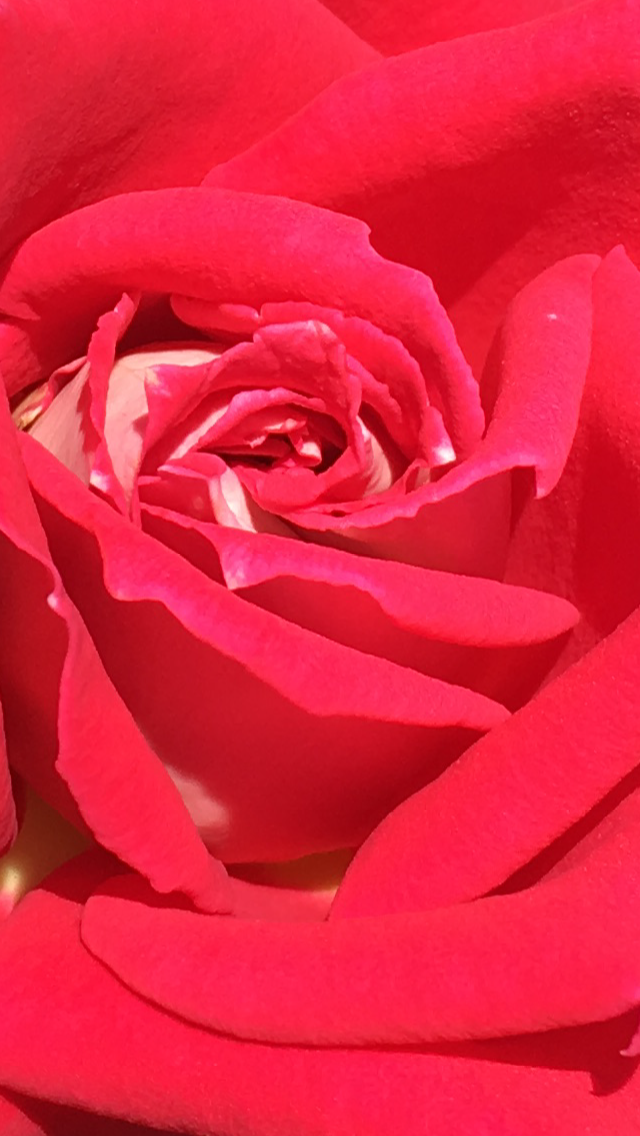
Good Fortune
Downvoting a post can decrease pending rewards and make it less visible. Common reasons:
Submit